One of my favorite dishes with trout is to make these trout rolls. Trout is both tasty and healthy - although I'm afraid I will spoil the latter a bit with this recipe. But who can resist fish, lemon, parsley and mustard?
Fishing is not all catch&release and I often keep fish when I'm catching. Trout are both tasty and healthy - although I'm afraid I will spoil the latter a bit with this recipe.
One of my favorite dishes with trout is to make these rolls. A good fish in the 1-1½ kilo or 2-3 lbs. class will make four very decent rolls. Filets from larger fish can be cut to even more strips and feed more people.
Ingredients
- Trout fillet (2-4 lbs. fish is perfect. You need 2-300 grams of fish fillet per person)
- Organic lemon (for zest)
- Mustard. I like a strong, sweet flavor like honey Dijon
- A small bunch of rinsed and dried parsley
- Thinly sliced dried ham. Italian style Parma ham or Spanish style serrano. Italian pancetta can do as a replacement and lean bacon will also do fine and even add a delicate smoked flavor.
- Salt and pepper
- Butter for frying
Sauce
- A cup of full cream
- Lemon zest from half a lemon
- Chopped string onion
- A tablespoonful of the mustard used above
Carbs
White rice, basmati or jasmine according to taste
or
Good home baked bread
You can also consider a mild salad consisting of different kinds and colors of lettuce - sweet and bitter mixed - with a dressing of lemon juice and olive oil and a bit of honey and salt.
Preparation
You will need to fillet the fish in order to make this dish. That is actually not difficult. Read the long explanation below.
Put a couple of tablespoonfuls of mustard into a small bowl and add the zest of half a lemon and the rinsed, dried chopped parsley and mix it to a paste.
Place the skinned and trimmed filets on a board and cut each into two narrow strips. You now have four strips of fish.
Smear the mustard paste onto the fish in an evenly, thin layer leaving the thinnest one inch uncovered. Place slices of ham or bacon on top, making sure the ham isn't wider than the fish. Again leave the thinnest one inch uncovered.
Start rolling the slices from the thick end and tip them over to finish the spiral. Stick a meat needle or a toothpick into the end to secure the roll.
Roll all four in a similar way and set aside.
If you are serving rice, start it now. It will usually take about about 20-25 minutes to finish, but simply follow the recipe on the package and time it with the rest.
Make the cold sauce by whipping the cream and adding string onion, lemon zest and a bit of mustard.
Frying
The fish will need to fry about 6-8 minutes plus the same time resting,
Heat a frying pan large enough for all four rolls. Add butter and let turn brown before setting the fish rolls in it. Fry them gently for about 3-4 minutes on one side. Add salt and pepper to the raw side, and turn them carefully over. Fry for another 3-4 minutes and add salt and pepper to the top side. Take the pan off the fire, put a lid on the pan and let the fish rest for at least 5 minutes while the rice finishes.
The fish will need to fry about 6-8 minutes plus the same time resting,
Arrange rice on a plate, set the fish on the plate and add some of the cold sauce, a bit of fresh lemon zest, a small twig of parsley and a lemon boat. Pour the fluid from the frying pan over the rice and serve immediately.
A cold, fresh and not too dry white wine will do fine. I like an Italian Frascati, but a good, fresh beer like a hefe (wheat beer or weissbier) is not a bad choice either. Choose what you prefer.
Fileting the fish
This the rather long and compex description of the filet procedure. It's easier to do than to describe.
I prefer to leave the gutted fish in the refrigerator overnight. The meat will set a bit and it becomes easier to part it from the bones. If the fish has been frozen, thaw it slowly in the fridge, which can take a day or two, and make sure it's all thawed, because just the least bit of frozen meat will make this proces much harder.
Leave head, tail and fins on the fish. That gives you some steering points and something to hold on to.
Lay the fish on its side on a large cutting board - preferably large enough to accommodate the full length of the fish. Us a sharp, narrow-bladed knife. Contrary to most beliefs it does not need to be a fillet knife. Any straight bladed kitchen knife will do as long as it's sharp and not too wide in the blade.
Lift up the breast fin and cut down half the height of the fish, stopping at the spine. Make sure that the head is separated from the fillet, but on one side only, and only almost halfway through, still firmly attached at the back.
Come in with the knife from the front of the fish right behind the head, the sharp edge of the knife pointing back towards the tail. Cut from just behind the head, and a bit down along the spine. The skin can be hard to penetrate, but once that is done, you should be able to cut easily. Lift the "corner" a bit and work with the knife deeper and deeper and further and further back. The closer you can get to the spine, the better. At a certain point the knife point starts working its way towards the ribs, and you will feel the lateral bones that come from the spine and go perpendicularly into the fillet.
Now is the time to get serious! Cutting these lateral bones properly is the first key to a good fillet. Grab the first loose part of the fillet firmly, and cut through the first of these side bones and the much softer rib under it. The first one is the toughest one. Cut the next and maybe the next. Now your fillet should start becoming separated from the skeleton, and you should be able to lift it and cut the last of the thicker lateral bones.
This leads to the next and final - and critical - part of the process.
Lay your knife flat against the spine, let the filet lay on top of it and hold onto the front part while cutting cutting the remaining side bones while separating the fillet from the carcass. The further you get, the easier it gets, but the larger the potential danger of the knife slipping and not cutting deep enough. You need to be as close as you can to the spine, all the way down to the tail.
You now have a fillet with skin on it. You will also have some ribs left, some pectoral fin and what-not. Remove any firm, bony stuff by cutting it fully away, skin and everything, but leave the ribs for now.
Lay the fillet on the skin side and come in with the knife from the tail end. Work it carefully until skin and flesh separates just a bit. Pinch the skin down towards the cutting board with your finger - maybe even just a nail - and with the knife absolutely flat against the board, slowly work your way towards the thick end of the fillet. Cut too deep, and the skin is cut. Cut too shallow, and flesh will be remain on the skin. We want neither.
This may sound difficult, but keeping the knife flat and parallel to the board is crucial, and once you have done it a few times, you will be able to easily repeat the task, leaving you with a thin layer of skin and a fillet almost ready to use.
If you left some ribs, now is the time to cut them off. Lay the knife flat against the meat and work it under the ribs towards the edge of the fillet, and cut as close as you can to the ribs, removing them and almost no meat.
The only remaining step is to pluck out the lateral bones, which are still left in the meat. If you run your fingers along the center of the inside of the fillet from the tail and forwards, you will be able to feel the bones. Use your fingernails, a pair of tweezers or a tong specially made for the purpose to pull them out.
In most cases you also remove the thin, floppy meat on the belly so that you get an evenly thick and almost rectangular filet. Save the meat trimmings. You can use them in the rolls.
- Log in to post comments

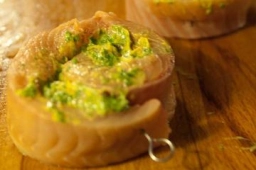
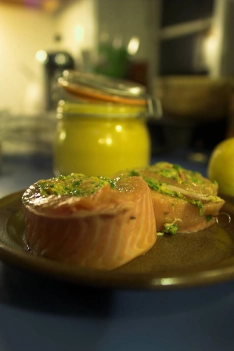
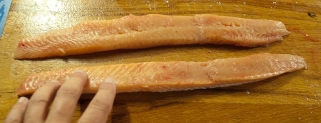
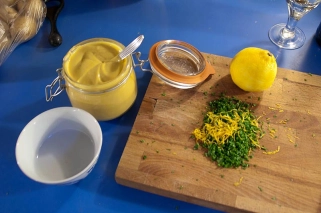
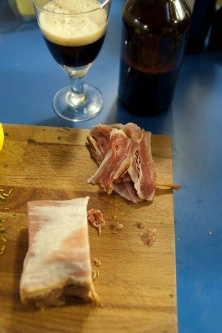
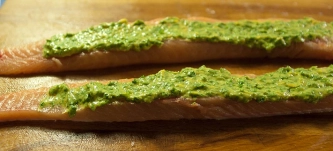

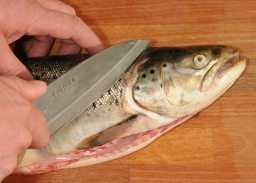

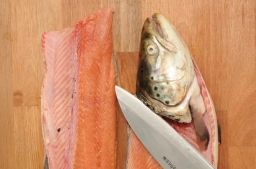
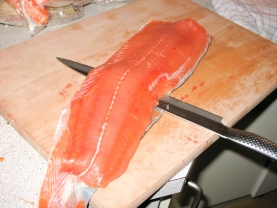
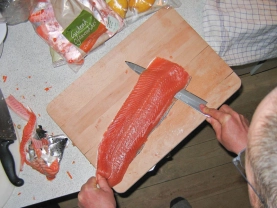
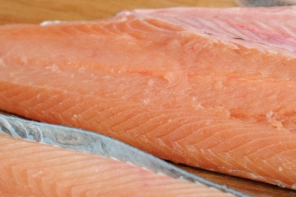

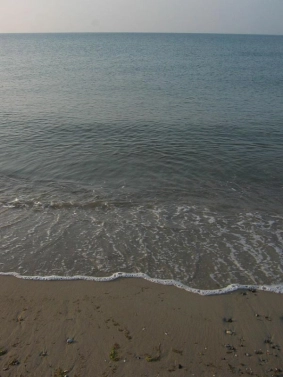
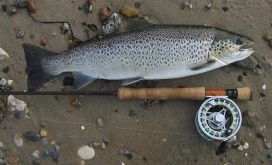
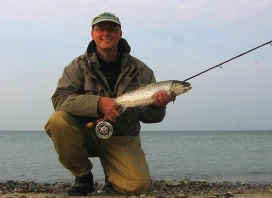


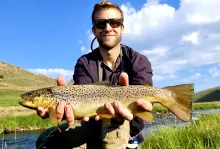

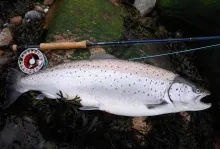


Nice looking recipe
Nice looking recipe I will have to try
Happy New Year and a great 2012 to you Martin